|
 |
keeping you - |
AWARE OF THE PAST
ABREAST OF THE PRESENT
ALERT ABOUT THE FUTURE |
|
 |
| |
| SEALS |
| |
|
| |
|
SEALS FROM MOHEN JO DARO
Mohenjodaro seals offer a valid record of the animal species that flourished in the lush Indus Valley in the third millennium BC including, from the top, the zebu bull with its prominent hump; the so-called unicorn, apparently another type of bull with its head shown in profile; the Indian rhinoceros, distinguisshed by its plate-like section of the skin; and the elephant, adorned here with a cloth. Although many seals found in the region bear similar designs, the inscriptions are bewilderingly deverse, suggesting that they represent proper names. Indus merchants used the seals as a kind of trademark, impressing them on clay tags to label their goods.
 
|
|
|
| |
|
Seals & Sealing
Long rectangular seals and a terra cotta sealing (bottom) with Indus script. The top seal has seven signs of Indus script. The back of this seal is convex and it is perforated from the side. The central sign may represent a house or temple and is a symbol that is often repeated on seals with horned deities seated in yogic position.
Material: fired white glazed steatite
Dimensions: 3.74 cm length, 1.47 cm wide
Mohenjo-daro, DK 5567
National Museum, Karachi, NMP 50.315

|
|
Indus tablets
The first one shows a Swastika

|
|
|
|
| |
|
Harappa Tablet
A three-sided tablet found in Harappa from the ancient Indus Civilization.This Harappan tablet is roughly 2,000 years older

|
|
Indus Tablet
Three sided molded tablet. One side shows a flat bottomed boat with a central hut that has leafy fronds at the top of two poles. Two birds sit on the deck and a large double rudder extends from the rear of the boat. On the second side is a snout nosed gharial with a fish in its mouth. The third side has eight symbols of the Indus script.
Material: terra cotta
Dimensions: 4.6 cm length, 1.2 x 1.5 cm width
Mohenjo-daro, MD 602
Islamabad Museum, NMP 1384

|
|
|
|
| |
|
Unicorn Seal, Mohenjodaro
Large square unicorn seal with perforated boss on the back. The unicorn is the most common motif on Indus seals and appears to represent a mythical animal that Greek and Roman sources trace back to the Indian subcontinent.
A relatively long inscription of eight symbols runs along the top of the seal. The elongated body and slender arching neck is typical of unicorn figurines, as are the tail with bushy end and the bovine hooves. This figure has a triple incised line depicting a pipal leaf shaped blanket or halter, while most unicorn figures have only a double incised line. The arching horn is depicted as if spiraling or ribbed, and the jowl is incised with multiple folds.
A collar or additional folds encircle the throat. In front of the unicorn is a ritual offering stand with droplets of water or sacred liquid along the bottom of the bowl. The top portion of the stand depicts a square grid or sieve, that actually may have been a circular cylinder.
Material: white fired glazed steatite
Dimensions: 5.08 x 5.08 cm
Mohenjo-daro, HR 743
National Museum, Karachi, NMP 50.192
 
|
|
|
|
|
|
|
This unicorn seal (below) was also discovered during the late 1927-31 excavations at Mohenjo-daro. One theory holds that the bull actually has two horns, but that these have been stylized to one because of the complexity of depicting three dimensions. However the manufacturing and design process behind seals was so sophisticated that the depiction of three dimensions might not necessarily have been a problem.

|
|
Intaglio Seal
Intaglio seal (below) with script and unicorn motif found in 1997. This seal dates to approximately 2200 BC, at the transition between Harappa.
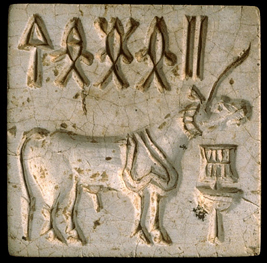
|
|
|
|
This seal(below) from Mohenjo-daro measures 29 mm (1.14) inches on each side and is made of fired steatite. Steatite is an easily carved soft stone that becomes hard after firing. On the top are four "pictographs" of an as yet undeciphered Indus script, one of the very first writing systems in history.
Below is the well-known unicorn figure of Indus Valley culture. Whether it designates a real or mythical animal is also unknown. Beneath it is a "sacred object," which could have been anything from an animal's trough to an incense burner.

|
|
Large Unicorn Seal
Large unicorn seal - dating to late Period 3C. This is one of the largest seals found from any Indus site.
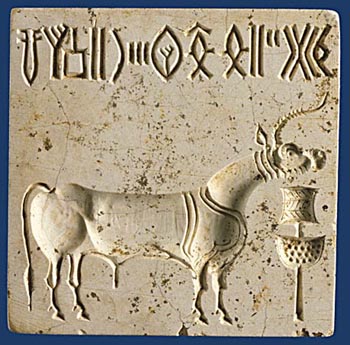
|
|
|
|
Excavation Site
It was one of 388 unicorn seals found during the excavations in Mohenjo-daro led by the British archaeologist Ernest Mackay between 1927 and 1931. Mackay dated the seal to the late Period IB, or approximately 2,000 B.C

|
|
"Trough."
The unicorn always has this object in front of it. There are at least five theories about this object. Mackay and Marshall thought it was the feeding trough or "manger" still seen in Sindh today. There is work connecting it to contemporary offering stands used in central India today. Mackay also guessed that it could have been a cage for birds or insects, or an incense burner. A fifth, more recent theory suggests that the object may have been the filter used to extract the intoxicating Soma drink described in the Rig Veda.
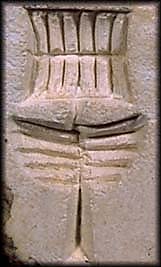
|
|
|
|
| |
|
Bull Seal Harappa
The majestic zebu bull, with its heavy dewlap and wide curving horns is perhaps the most impressive motif found on the Indus seals. Generally carved on large seals with relatively short inscriptions, the zebu motif is found almost exclusively at the largest cities of Mohenjo-daro and Harappa.
The rarity of zebu seals is curious because the humped bull is a recurring theme in many of the ritual and decorative arts of the Indus region, appearing on painted pottery and as figurines long before the rise of cities and continuing on into later historical times. The zebu bull may symbolize the leader of the herd, whose strength and virility protects the herd and ensures the procreation of the species or it stands for a sacrificial animal. When carved in stone, the zebu bull probably represents the most powerful clan or top officials of Mohenjo-daro and Harappa.
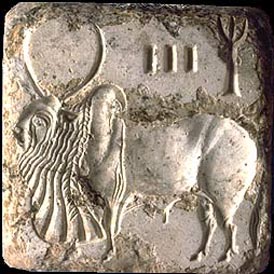 
|
|
|
| |
|
Bison Seal Mohenjodaro
This is a flat square double sided seal. On one side, four script symbols are inscribed in reverse, above a bison with head lowered to the feeding trough. A swastika motif turning counter clockwise is carved on the reverse. The seal is perforated from the side along the axis of the animal motif.
Material: gray brown unfired steatite
Dimensions: 2.04 x 2.04 cm, 0.74 cm thickness
Mohenjo-daro, HR 4503
Mohenjo-daro Museum, 50.258, MM 487
 
|
|
|
| |
|
Inscribed Objects
A collection of inscribed objects found along the main street leading to the southern gateway at Harappa. The fragmentary seal on the left is the earliest seal found to date, and depicts a bovine carved in a very archaic style. At the top center is a terra cotta sealing with two seal impressions. This sealing may have been used to close a large jar full of trade goods such as oil.
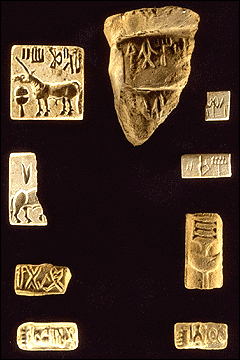
|
|
Seals & Tablets
A collection of seals and tablets from a single house along the main street leading to the southern gateway at Harappa. The association of these different types of objects together in one house show that some people, possibly merchants, were using a wide variety of inscribed objects.

|
|
|
|
| |
|
Mohenjodaro Seal
Terracotta sealing from Mohenjo-daro depicting a collection of animals and some script symbols. This sealing may have been used in specific rituals as a narrative token that tells the story of an important myth.

|
|
Mohenjodaro Seal
Square seal depicting a nude male deity with three faces, seated in yogic position on a throne, wearing bangles on both arms and an elaborate headdress. Five symbols of the Indus script appear on either side of the headdress which is made of two outward projecting buffalo style curved horns, with two upward projecting points. A single branch with three pipal leaves rises from the middle of the headdress.
Seven bangles are depicted on the left arm and six on the right, with the hands resting on the knees. The heels are pressed together under the groin and the feet project beyond the edge of the throne. The feet of the throne are carved with the hoof of a bovine as is seen on the bull and unicorn seals. The seal may not have been fired, but the stone is very hard. A grooved and perforated boss is present on the back of the seal.
Material: tan steatite
Dimensions: 2.65 x 2.7 cm, 0.83 to 0.86 thickness
Mohenjo-daro, DK 12050
Islamabad Museum, NMP 50.296

|
|
|
|
| |
|
Mohenjodaro Seal
Seal depicting a deity with horned headdress and bangles on both arms, standing in a pipal (sacred fig) tree and looking down on a kneeling worshiper. A human head rests on a small stool. A giant ram and seven figures in procession complete the narrative. The figures wear a single plumed headdress, bangles on both arms and long skirts.
Several script signs are interspersed with the figures along the top of the seal and a single sign is placed at the base of the tree. This scene may represent a special ritual sacrifice to a deity with seven figures in procession. The seal has a grooved and perforated boss and the edges are worn and rounded from repeated use.
Material: fired tan steatite with traces of glaze
Dimensions: 4.06 x 3.95 cm, 0.8 cm thickness.
Mohenjo-daro DK 6847
Islamabad Museum, NMP 50.295

|
|
Mohenjodaro Seal
Square seal with multiple headed animal depicting three important totemic animals: the bull, the unicorn, and the antelope. All three animals are seen individually on other seals along with script, but this seal has no script.
Material: gray brown steatite
Dimensions: 2.4 x 2.4 cm, 0.53 cm thickness
Mohenjo-daro, DK 7734
Islamabad Museum, NMP 50.289
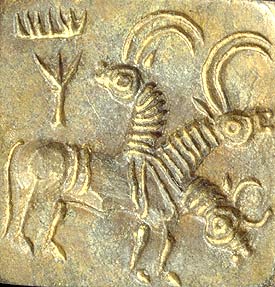
|
|
|
|
| |
|
Mohenjodaro Seal
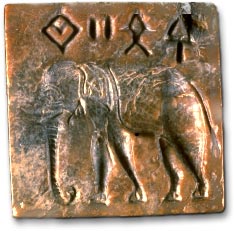
|
|
Mohenjodaro Silver Seal
This silver seal with a unicorn motif is one of two found at Mohenjo-daro.

|
|
|
|
| |
|
Mohenjodaro Seals
Other animal motifs appearing on seals found primarily at the largest cities include dangerous wild animals like the rhinoceros, the water buffalo, the gharial (crocodile) and the tiger. All of these animals would have been familiar to people living at the edge of the thick jungles and swampy grasslands of the Indus plain and they were revered as totemic animals, closely associated with important myths and legends.
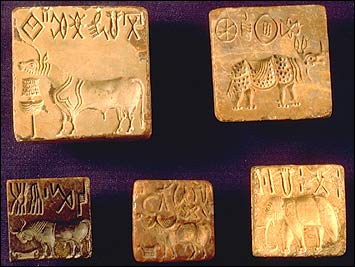
|
|
Tokens or tablets, Harappa
Terra cotta tokens or tablets from Harappa. Recently, excavators found a concentration of as many as 31 identical cylindrical terracotta tablets (top center), but it is not known what they could have been used for.
Concentrations of tablets recovered through recent excavations at Harappa indicate that these tablets become popular during the late part of Period 3B (2450 B.C) and continue on into the final phase of the Harappan occupation, Period 3C (2200 to 1900 B.C.).

|
|
|
|
| |
|
Molded Tablet
Plano convex molded tablet showing an individual spearing a water buffalo with one foot pressing the head down and one arm holding the tip of a horn. A gharial is depicted above the sacrifice scene and a figure seated in yogic position, wearing a horned headdress, looks on. The horned headdress has a branch with three prongs or leaves emerging from the center.
On the reverse, a female deity is battling two tigers and standing above an elephant. A single Indus script depicting a spoked wheel is above the head of the deity.
Material: terra cotta
Dimensions: 3.91 length, 1.5 to 1.62 cm width
Harappa, Lot 4651-01
Harappa Museum, H95-2486

|
 |
|
|
| |
|
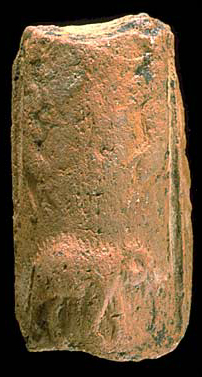
|
Tablet with man-in-tree and tiger(from Harappa)
Molded terracotta tablet with a narrative scene of a man in a tree with a tiger looking back over its shoulder. The tablet is broken, but was made with the same mold. The reverse of the same molded terra cotta tablet shows a deity grappling with two tigers and standing above an elephant

|
|
|
| |
|
Elephant Faience Tablet.(from Harappa)
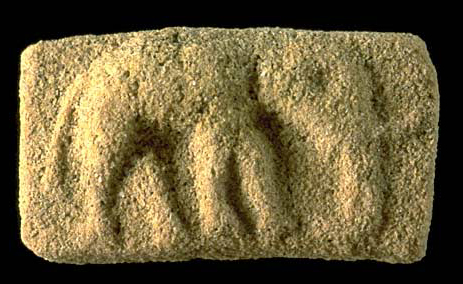
|
|
|
| |
|
Button Seal
This fired steatite button seal from the Kot Dijian Phase (Period 2, 2800-2600 BC) shows a unique pattern that may be an early form of the Harappan script sign that may represent "house" or "temple."
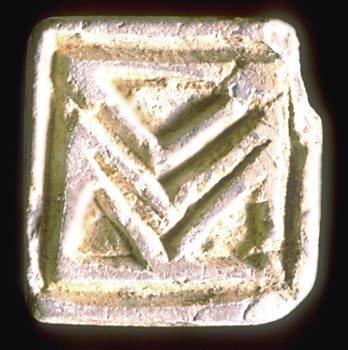
|
|
The intricately carved seals of the Indus Civilization were probably used in trade. Typically square with each side measuring from two to five centimeters, the obverse of most seals was engraved with mythical scenes or animals and an average of five Indus script signs. The square seals also had a small boss on the back through which a string or a cord had been passed, allowing them to be worn or otherwise secured. While the Indus script remains undeciphered, approximately 400 signs have been identified thus far in what was probably a logo-syllabic writing system in which the signs were read from right to left.

|
|
|
|
| |
|
Faience Button Seal
A faience button seal with geometric motif was found at Harappa by one of the workmen.
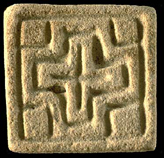
|
|
Faience Button Seal with Swastika Motif
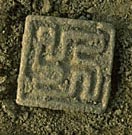
|
|
|
|
| |
|
Steatite Button Seal
Fired steatite button seal with four concentric circle designs from Harappa
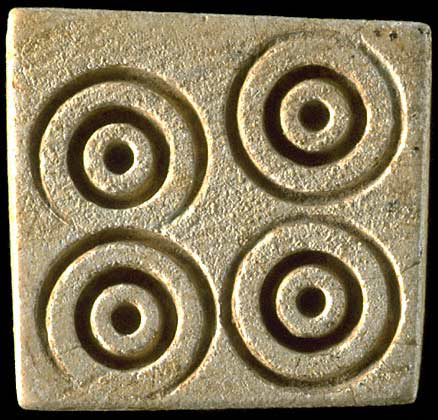
|
|
|
| |
|
Three Clay Sealings
Three clay sealings from the Harappa Phase levels (2600-1900 BC) that may have come from large bundles of goods shipped to the site from a distant region. The clay does not appear to be the same type of clay as found near Harappa and each sealing has the impression of two different seals.

|
|
|
| |
|
Molded Tablets
Molded tablets sometimes have impressions on one, two, three or four sides. This group of molded tablets shows the complete set of motifs. One side is comprised entirely of script and has six characters, the first of which (on the very top) appears to be some sort of animal. A second side shows a human figure grappling with a short horned bull. A small plant with at least six branches is discernible behind the individual. The third panel portrays a figure seated on a charpoy or throne in a yogic position, with arms resting on the knees. Both arms are covered with bangles, and traces of a horned headdress and long hair are visible on some of the impressions. A second individual, also with long hair and wearing bangles, is seated on a short stool to the proper left of the individual on the "throne." The fourth panel shows a deity standing with both feet on the ground and wearing a horned headdress. A branch with three pipal leaves projects from the center of the headdress. Bangles on seen on both arms.

|
|
|
| |
|
Three Groups of Tablets
Three groups of tablets can be defined on the basis of the type of tool used to incise them and the style of inscribing. The most complex script sign appears to have been made with different numbers of strokes for each of the three groups. This sign looks like a person carrying two containers and with the horned U shape sign where the head should be. The different strokes used to create this sign reflect three different styles of hand writing. Groups 1, 2 and 3 were probably inscribed by different scribes.

|
|
|
| |
|
Two Inscribed Tablets
These two inscribed tablets (c. 2300 BC) have the same inscription, but it was written in opposite directions.

|
|
|
| |
|
Long Rectangular Seal with no Animal Motif
This type of seal is only found in the last part of the Harappan Phase, Period 3C. A similar rectangular seal was found in the 1998 excavations of the circular platforms
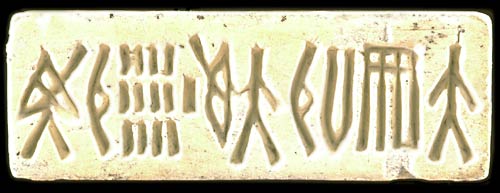
|
|
|
| |
|
Sealing
One of the longer inscriptions made from a seal found during Mackay's excavations between 1927-1931 in Mohenjo-daro. There are few long Indus inscriptions; another similarly long inscription was recently found on a wooden signboard in Dholavira, Gujarat, India.

|
|
|
| |
|
Harappan Faience Tablet or Standard
This unique mold-made faience tablet or standard was found in the eroded levels west of the tablet workshop. On one side is a short inscription under a rectangular box filled with 24 dots. The reverse has a narrative scene with two bulls fighting under a thorny tree.
 
|
|
|
| |
|
Tablet with Script
Mold-made faience tablet with script found in the eroded surface debris of Trench 54 at Harappa.

|
|
|
| |
|
Unique Two Colored Tablet (from Harappa)
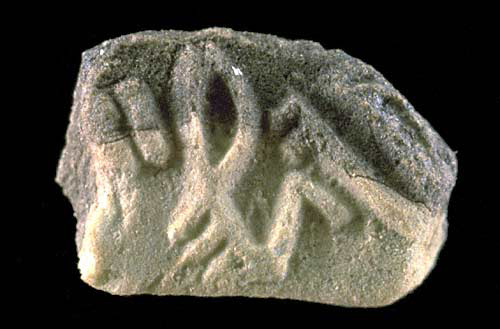
|
|
|
| |
|
Inscribed Steatite Tablets(from Harappa)
Inscribed steatite tablets made from two different colors of steatite have the same inscription. The sloppy nature of the inscription may be the reason why these tablets were discarded. Both tablets, incised on one side only, were found in the same excavation unit - South steatite and faience workshop in Harappa.

|
|
|
| |
|